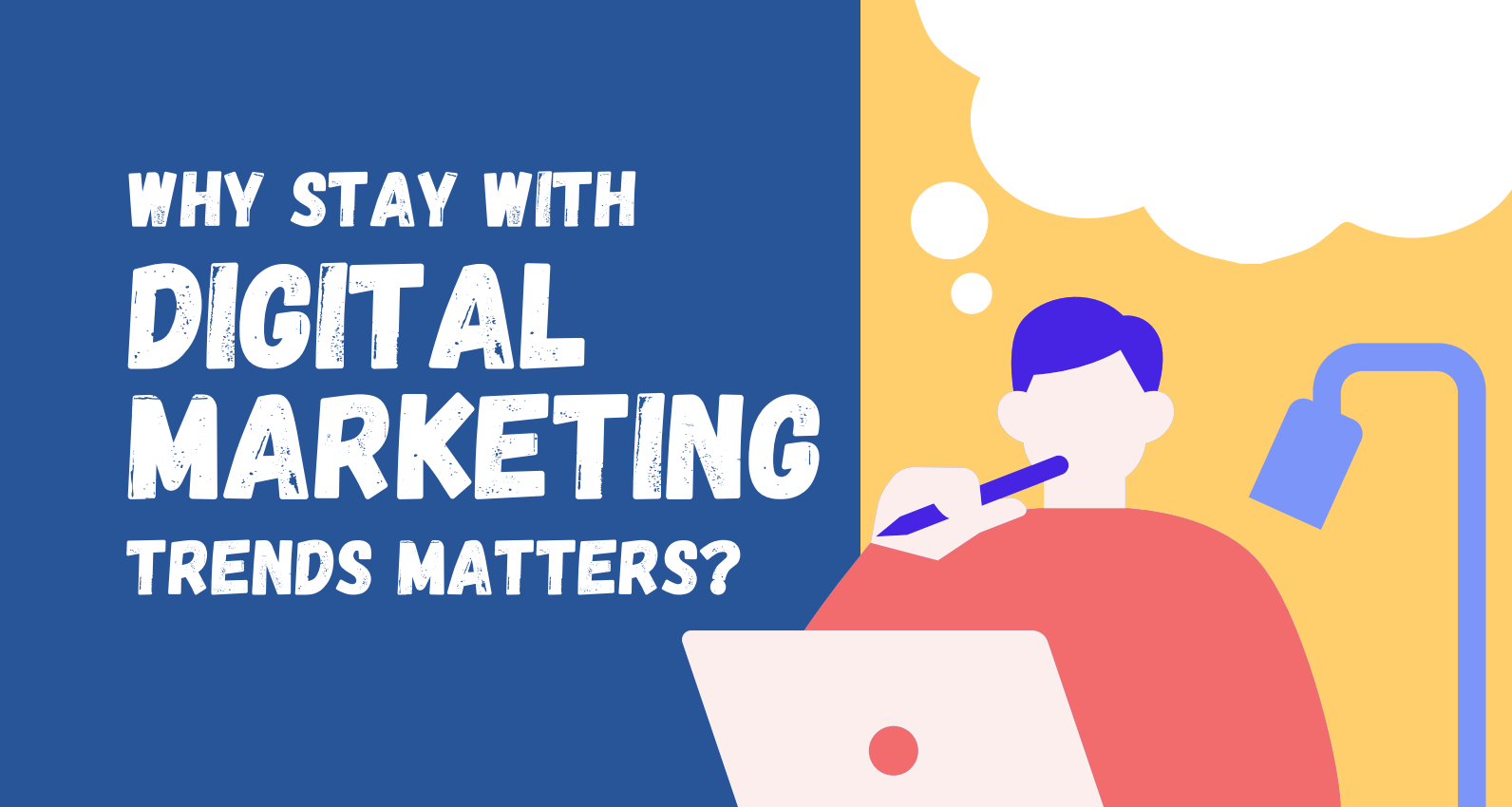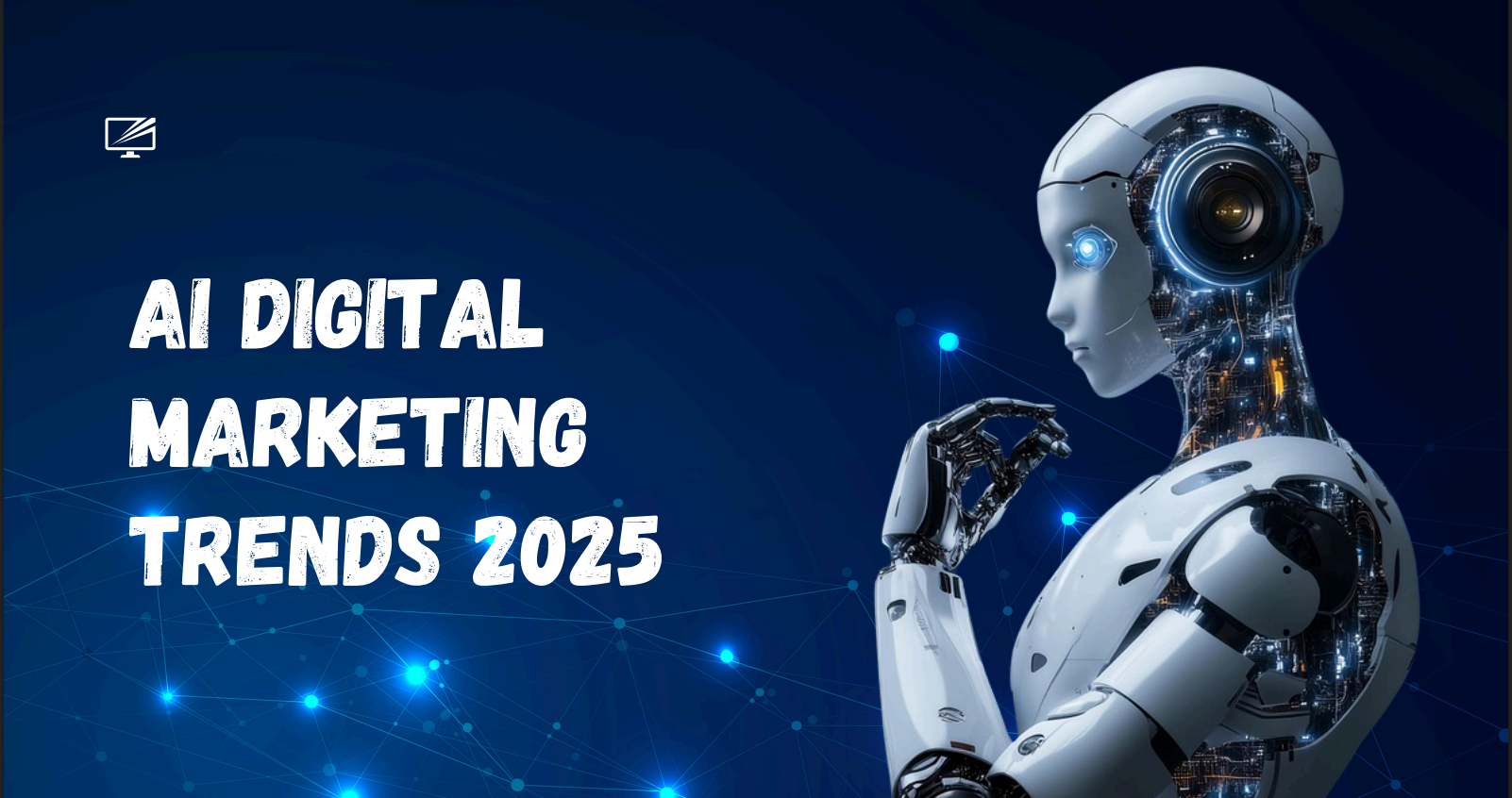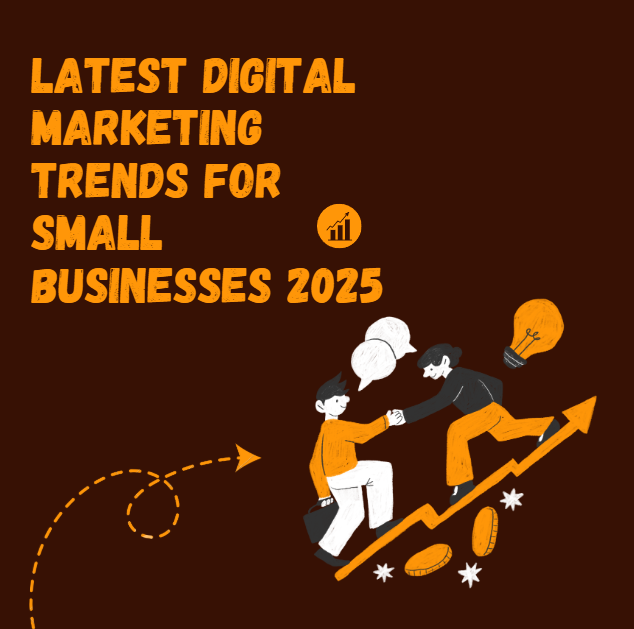Digital Marketing Trends In 2025
By Admin

Discover the top Digital Marketing Trends in 2025 that help brands grow faster, connect better, and stay ahead in today’s competitive market
Digital Marketing Trends In 2025
Digital marketing continues to evolve quickly, and in 2025, it's more important than ever to keep up with the latest changes. Businesses are using smarter tools and better strategies to reach people online. From using artificial intelligence to new trends on social media, digital marketing in 2025 is all about creating a better experience for customers.
In this guide, we’ll explore the top digital marketing trends 2025 that are already shaping how companies promote their products and services. This isn’t just about predictions — it’s based on what’s really happening right now across industries, tools, and platforms.

Why Staying Updated with Digital Marketing Trends Matters?
Digital marketing is always changing. What worked last year may not work today. That’s why it's important to stay updated with the latest digital marketing trends. It helps businesses grow, connect with customers better, and stay ahead of competitors.
1. Changes in Consumer Behavior
People change how they search, shop, and interact online. New apps, features, and tools come out all the time. When businesses keep up with these changes, they can reach customers more effectively. For example, short videos are now more popular than long articles.
2. Better Engagement
New marketing trends often focus on better ways to talk to customers. Whether it’s using Instagram Reels, chatbots, or interactive content, following the trend helps you grab attention. When you use updated tools, customers are more likely to notice and respond.
3. Staying Ahead of Competitors
If you don’t follow the trends, your competitors will. They’ll use the latest strategies and take your place in the market. Staying updated gives you an edge and helps you offer something fresh and different to your audience.
4. Improved Results with Less Effort
Modern marketing tools help save time and get better results. For example, email automation or AI tools can help create personalized content quickly. By learning about these tools, you can do smarter work without spending more time or money.
5. Reaching the Right Audience
Trends often highlight where your audience is spending time. If most people now use TikTok or voice search, sticking to old methods like only using emails or flyers won’t help. Being updated helps you meet people where they are.
6. Building Trust and Credibility
Brands that follow new trends look more professional and trustworthy. If your website, content, or social media feels modern, people believe you're active and reliable. Outdated methods can make a business seem lazy or out of touch.
7. Boosting SEO and Online Visibility
Search engines like Google change their rules often. If you don’t follow new SEO practices, your content may not show up in search results. Learning the latest SEO tips helps keep your website visible and drives more traffic.

AI Digital Marketing Trends 2025
Artificial Intelligence (AI) is changing how marketers work. But in 2025, it’s no longer a “futuristic” idea — it’s something many businesses are using daily.
Here are the most practical AI digital marketing trends in 2025:
1. AI-Powered Content Creation
Tools like ChatGPT, Jasper, and Copy.ai are helping marketers write content faster. These tools don’t just save time — they can also improve quality. Many businesses now use AI to:
- Write blog posts and social media captions
- Create product descriptions
- Brainstorm headlines and taglines
However, most successful marketers still review and edit the content to make sure it sounds human and matches their brand.
2. Smarter Chatbots for Customer Support
AI-powered chatbots are better than ever. In 2025, many websites use them to answer questions 24/7. These bots understand natural language, so users feel like they’re chatting with a real person.
Benefits:
- Faster customer service
- Lower support costs
- Better user experience
3. AI in Email Personalization
Marketers now use AI to personalize emails based on what people do on a website or app. For example:
- If someone looks at running shoes, they may get an email showing new running shoe styles.
- If they stop at checkout, they may get a reminder with a special offer.
This helps increase email open rates and sales.
4. Predictive Analytics
AI helps predict customer behavior. This means marketers can send the right message to the right person at the right time. For example:
- Suggesting products based on shopping history
- Showing ads to users more likely to buy
This reduces waste in ad budgets and improves return on investment (ROI).
Video Content Is Leading the Way
In 2025, video is the king of digital content. People love watching videos more than reading long text. Here’s how businesses are using video:
Short-Form Videos
Platforms like TikTok, Instagram Reels, and YouTube Shorts continue to grow. These short clips are perfect for:
- Showing products in action
- Sharing quick tips
- Building brand personality
Tip: Keep videos under 60 seconds and make sure they are fun, clear, and useful.
Live Streaming
Live video helps businesses talk directly with their audience. Brands use it to:
- Launch new products
- Host Q&A sessions
- Give behind-the-scenes tours
Live videos feel more real and help build trust.
AI Video Tools
In 2025, AI tools like Synthesia and Pictory help create videos without needing actors or cameras. Marketers use these tools to:
- Create training content
- Translate videos into multiple languages
Social Media Marketing Trends in 2025
Social media marketing has become one of the most powerful tools for businesses today. In 2025, it continues to grow fast—but not with guesswork. Real trends are shaping how brands connect with people and share their stories online.
Let’s look at what’s actually working right now in 2025.
1. Short Videos Still Lead
Platforms like TikTok, Instagram Reels, and YouTube Shorts are still the top choice for content. Brands use short videos to share quick tips, behind-the-scenes clips, and product teasers. These videos are easy to watch and often go viral, helping brands grow fast.
2. User-Generated Content (UGC) Builds Trust
Many companies now ask their customers to create content—like reviews, photos, or unboxing videos. This is called user-generated content. It feels real and honest, so other people trust it more than ads. In 2025, UGC is one of the most powerful tools on social media.
3. Influencer Partnerships Are Smarter
Instead of using only big celebrities, brands now work with micro and nano influencers. These influencers have smaller but loyal audiences. Their followers trust their advice, so the results are often better. It's cost-effective and drives real engagement.
4. Social Commerce Is the New Shopping Mall
People are now shopping directly from apps like Facebook, Instagram, and TikTok. In 2025, many brands set up full stores inside social platforms. Customers can browse, click, and buy—without ever leaving the app.
5. Real-Time Content Wins Attention
Live videos, Q&A sessions, and quick updates are more popular than polished ads. Brands are going live on Facebook or Instagram to chat with their audience, show new products, or share exciting news. This creates a personal connection with followers.
6. AI-Powered Content Suggestions
Social media platforms now use AI to decide what content people see. Businesses use this too. Tools help them find the best time to post, the right hashtags, and topics people are talking about. It saves time and improves reach.
7. Better Customer Service Through DMs
Customers now expect fast replies on platforms like Messenger, WhatsApp, and Instagram. Many brands use chatbots and real team members to answer questions quickly. It helps build trust and makes people feel heard.
8. Focus on Community, Not Just Promotion
Brands are moving away from only posting ads. In 2025, they are building real online communities. They ask questions, run polls, reply to comments, and support causes. This makes followers feel like part of a bigger story.

Latest Digital Marketing Trends for Small Businesses 2025
Running a small business in 2025 is exciting—but also competitive. With so many businesses online, it’s important to stay updated with what’s working in digital marketing right now. This guide covers the latest digital marketing trends that are already helping small businesses grow in 2025. These are not future predictions. These are real things happening today that you can use in your business.
Let’s break them down simply.
1. Short-Form Video Content is Winning
Small businesses are using short videos (under 60 seconds) to connect with customers on platforms like TikTok, Instagram Reels, and YouTube Shorts.
Why it works:
- Easy to create using just a phone
- Gets more views than long videos
- Feels personal and fun
What you can do:
- Show behind-the-scenes clips of your business
- Share quick tips or product demos
- Use trending sounds or hashtags
Example: A local bakery posts daily 15-second clips showing the fresh items they bake—customers love it!
2. Local SEO is More Powerful Than Ever
Local SEO means showing up when people nearby search online. In 2025, Google gives more space to local results in search, maps, and voice searches.
How small businesses benefit:
- Brings real, nearby customers
- Increases walk-in traffic or local calls
What to do:
- Make sure your Google Business Profile is complete and updated
- Ask happy customers to leave reviews
- Use location-based keywords like “best pizza in Chittagong”
Example: A home repair service in Dhaka saw 40% more calls just by updating their Google profile and adding fresh photos.
3. Conversational Marketing with AI Chatbots
More small businesses are using AI-powered chatbots to answer questions instantly on websites and Facebook pages.
Why it matters:
- Helps customers 24/7 (even at night!)
- Saves time for business owners
- Feels personal and fast
Where to start:
- Use tools like ManyChat, Tidio, or Meta AI chatbot
- Set up FAQs, like pricing, hours, or services
Example: A salon added a chatbot to its website and started getting 3x more bookings at night when staff weren’t available.
4. Personalized Email Marketing Still Works
Email marketing isn’t dead—it’s smarter now. In 2025, small businesses are using personalized emails to reach customers better.
How it helps:
- Emails feel more relevant
- Higher open and click rates
- Builds trust with repeat buyers
Tips to do it right:
- Use first names in subject lines
- Segment your email list by interest or behavior
- Share special offers or helpful tips
Example: A handmade soap brand sends emails about dry skin in winter and oily skin in summer. Sales increased by 25%.
5. Influencer Collaborations with Nano-Creators
Big influencers are expensive. But in 2025, nano-influencers (people with 1,000–10,000 followers) are helping small businesses grow.
Why nano-influencers work:
- More trust from their audience
- Higher engagement
- Affordable for small businesses
How to use them:
- Find local creators who match your brand
- Offer free products or small payments
- Ask for honest reviews or shoutouts
Example: A small clothing store teamed up with a student influencer who styled their outfits on Instagram—sales doubled that week.
6. AI Tools for Content Creation and Scheduling
AI isn’t just for big brands. Small businesses now use tools like ChatGPT, Canva, and Buffer to create posts, write captions, and plan content.
Benefits:
- Saves time
- Makes your brand look professional
- Keeps your social media active
Simple AI tools to try:
- Canva: for graphics and reels
- ChatGPT: for blog and caption writing
- Buffer / Publer: for scheduling posts
Example: A flower shop uses AI to write posts for Mother’s Day and schedule them a week in advance—no last-minute stress!
7. Social Proof and User-Generated Content
In 2025, customers want to see real people using your products before buying. That’s why user-generated content (UGC) is a strong trend.
How to collect UGC:
- Ask customers to post photos or videos and tag you
- Run a contest or giveaway
- Re-share customer reviews and posts
Why it works:
- Builds trust fast
- Looks real (not like ads)
- Creates community
Example: A coffee shop reposts photos from customers who tag their drinks—followers feel involved and visit more often.
8. Voice Search Optimization
With smart speakers and mobile assistants, more people use voice search like “Where’s the nearest gift shop?” Small businesses are optimizing for this trend.
What helps:
- Use clear, natural sentences in your website copy
- Add FAQs like “What are your hours?” or “How much is delivery?”
- Focus on “near me” phrases
Example: A bike repair shop added FAQ pages with voice-friendly text—and saw more local searches and calls.
9. Social Media Selling (Social Commerce)
In 2025, small businesses are selling directly from Instagram, Facebook, and TikTok. Customers can shop without leaving the app.
Why this matters:
- Fewer clicks = more sales
- Builds trust with visual shopping
- Makes the buying process fun and easy
Tips to get started:
- Add a shop tab on Instagram or Facebook
- Tag products in photos and reels
- Use live shopping (go live and show products)
Example: A jewelry business sells 30% of its items from live Instagram sales every Friday night.
10. Mobile-First Websites and Fast Loading Speed
People now shop and browse more on phones than on computers. Google also favors mobile-friendly websites.
Small business tip:
- Make sure your website loads fast
- Keep it simple and clean on phones
- Use big buttons and readable fonts
Use tools like:
- Google PageSpeed Insights
- Mobile-friendly testing tools
Example: A home decor site fixed slow loading and saw a 45% drop in bounce rate from mobile users.

Digital Marketing Trends 2025 for eCommerce Brands
In 2025, digital marketing for eCommerce brands is more focused, smarter, and customer-driven than ever before. These are not predictions — these are real trends that brands are already using right now to grow sales and build trust.
If you run an online store or want to grow your eCommerce brand, these trends can help you stay ahead.
1. Short Videos Are Driving Sales
Short videos on platforms like TikTok, Instagram Reels, and YouTube Shorts are helping brands showcase products fast. Shoppers love to see quick demos, unboxings, and reviews.
If you’re selling online, creating short and simple videos is a must. It helps customers understand your product in just a few seconds.
2. Social Media = Shopping Platform
People now buy directly from Facebook, Instagram, and TikTok shops without visiting a website. Many eCommerce stores have built-in social commerce options where users can browse, click, and checkout — all inside the app.
This trend makes it easier for brands to sell faster and to a wider audience.
3. User-Generated Content Builds Trust
Real customer photos, reviews, and videos are being used more than polished ads. eCommerce brands are sharing this content on their websites and social media.
This helps build trust. When people see others using your product, they’re more likely to buy it too.
4. Email Marketing Still Works — When Done Right
Email marketing hasn’t gone away. But now it’s more personalized. Smart eCommerce brands send emails with product suggestions based on what a customer looked at or bought before.
This makes the message feel helpful — not annoying.
5. Fast Websites = More Sales
In 2025, website speed is a big deal. People leave slow websites quickly. eCommerce brands are making sure their websites load in 3 seconds or less — especially on mobile.
A fast site keeps customers happy and improves search engine ranking too.
6. Search Is Changing — Voice and AI Are Here
People now search for products using voice assistants like Siri, Alexa, or Google Assistant. They also use AI tools to ask product-related questions.
Brands are optimizing their websites and product pages with simple, clear answers that show up in these voice or AI-based searches.
7. Chatbots Improve Customer Support
Quick replies are important. eCommerce brands are using AI chatbots on websites and social media to answer customer questions 24/7.
This helps customers feel supported and can increase conversions by solving doubts fast.
8. Personalized Ads Are Getting Smarter
Digital ads in 2025 are more targeted than ever. Brands use data to show the right product to the right person at the right time. Platforms like Google Ads and Meta Ads allow stores to run highly targeted campaigns based on interests, age, or shopping habits.
This means less wasted money and better results.
9. Mobile-First Marketing Is a Must
Most shoppers use their phones to browse and buy. That’s why eCommerce brands are now designing ads, websites, and emails with mobile-first in mind. Everything needs to look great and load fast on a smartphone.
10. Customer Reviews and Ratings Matter More
In 2025, people check reviews before buying. Brands that encourage happy customers to leave reviews are winning more sales. Adding product ratings and customer comments on product pages helps build trust and reduce return rates.
How Digital Marketing Will Change in 2025
Digital marketing in 2025 isn’t just about the future — it’s already changing right now. Businesses are using smarter tools, faster platforms, and more personal ways to connect with their customers.
Let’s explore how digital marketing is changing in 2025, based on what’s really happening — not just predictions.
1. Short Video Is the New King
Short videos on platforms like TikTok, Instagram Reels, and YouTube Shorts are becoming the top way brands share their messages. These videos are fun, quick, and easy to understand.
People love seeing how a product works in just 10–30 seconds. Businesses that use short videos are seeing better results and more customer interest.
2. People Buy Directly from Social Media
Social media is no longer just for chatting or sharing photos. In 2025, platforms like Facebook, Instagram, TikTok, and WhatsApp let you buy directly from posts and messages.
Brands are setting up online shops inside these apps, making shopping super simple and fast for users.
3. Marketing is More Personalized
In 2025, marketing is all about personal connections. Brands are sending messages that match each person’s interests, past purchases, or browsing behavior.
Whether it’s an ad, email, or text, customers now get content that feels made just for them.
4. AI Is Helping Marketers Save Time
Artificial Intelligence (AI) is now doing real work in digital marketing. Tools powered by AI can write product descriptions, reply to customer chats, and even suggest better headlines.
This saves time and helps brands focus more on creative ideas and customer care.
5. Chatbots Are Getting Smarter
In 2025, businesses use AI chatbots to help customers 24/7. These bots answer questions, suggest products, and help with problems — even when no human is online.
Good customer support means happier shoppers and more sales.
6. Voice Search Is Growing
Many people now use voice assistants like Siri, Google Assistant, or Alexa to find things online. That means brands must write their content in a way that sounds natural and answers real questions clearly.
Voice-friendly content helps your business get found more easily.
7. Mobile Experience Comes First
Most people now shop, search, and scroll on their phones — not laptops. That’s why smart brands design everything mobile-first.
Fast-loading pages, clean designs, and easy checkout make mobile users happy. In 2025, mobile-first isn’t a choice — it’s a must.
8. Data Privacy Is Important
Customers care about their personal information. Brands are now being more careful with data and following privacy laws. They also tell users how their data is used and give them control.
This builds trust and keeps customers loyal.
9. Content Needs to Be Real and Useful
People don’t want sales talk. They want real stories, how-to guides, and honest reviews. In 2025, helpful and simple content works better than flashy ads.
Brands that teach and help win more trust and attention.
10. Email Still Works — But It’s Smarter
Email isn’t dead. It’s smarter now. Brands send personal emails based on what customers like, what they clicked, or what they added to their cart.
These emails feel helpful — not annoying — and they lead to more sales.
Why Staying Updated with Digital Marketing Trends Matters
Digital marketing changes fast. What worked last year may not work today. That’s why staying updated with digital marketing trends is so important for businesses, marketers, and creators.
Let’s explore the real reasons why keeping up with changes in digital marketing really matters.
]
1. The Internet Never Sleeps
People are online all the time — shopping, scrolling, searching, and sharing. New tools, apps, and features come out every day. If you don’t stay updated, you miss chances to connect with your audience where they already are.
Example: Instagram added “Reels,” and brands that used them early gained followers faster.
]
2. Customer Behavior Keeps Changing
What customers like and how they shop keeps changing. Maybe people used to read long blog posts, but now they prefer short videos. If you follow the latest trends, you’ll know how to speak your customer’s language.
Real tip: Knowing what your audience likes helps you create content that works better.
]
3. Competitors Are Evolving Too
Other businesses are watching trends — and using them. If you don’t keep up, you could fall behind. Staying updated helps you stay competitive and even move ahead.
Being updated = staying relevant = more sales and growth.
4. It Saves Time and Money
Using old methods can waste your budget. New tools and strategies often make things faster and cheaper. Learning what’s working now means your marketing will be more effective.
Example: Instead of spending money on random ads, using targeted Facebook ads brings better results.
5. Improves Customer Experience
People expect smooth, modern, and helpful online experiences. When you stay updated, you can meet those expectations. This builds trust and makes customers want to return.
Smart brands give people what they want — when and where they want it.
6. It Helps You Use New Tools Better
Digital marketing trends often include new tools like AI chatbots, email automation, or SEO updates. Learning how to use these can save hours of work and boost your results.
Learning = growing. Growing = more success.
7. Google and Social Media Keep Changing Rules
Search engines and social media platforms often update their rules and algorithms. If you don’t know what changed, your content might stop reaching people. Staying updated helps you follow best practices.
Example: Google’s helpful content updates reward websites that offer real value.
8. Trends Can Inspire New Ideas
Sometimes, following trends gives you fresh ideas. You might see a campaign, tool, or format you haven’t tried before. This can help you stand out and reach new people.
Fresh ideas keep your marketing fun and exciting.
Final Thoughts
Digital marketing trends 2025 are all about personalization, speed, and connection. Real tools like AI, short videos, better data, and automation are helping marketers create smarter strategies. The key to success in 2025 is not about guessing the future — it’s about using what already works and making it better for your audience.
Quick Tips Recap:
- Use AI tools to speed up and improve marketing tasks
- Focus on creating helpful, clear, human-centered content
- Build trust with real stories, real people, and real value
- Keep up with platform updates (like TikTok and Instagram features)
- Collect and protect user data with care
By following these current trends, your digital marketing efforts will stay strong and effective in 2025 — and beyond.







